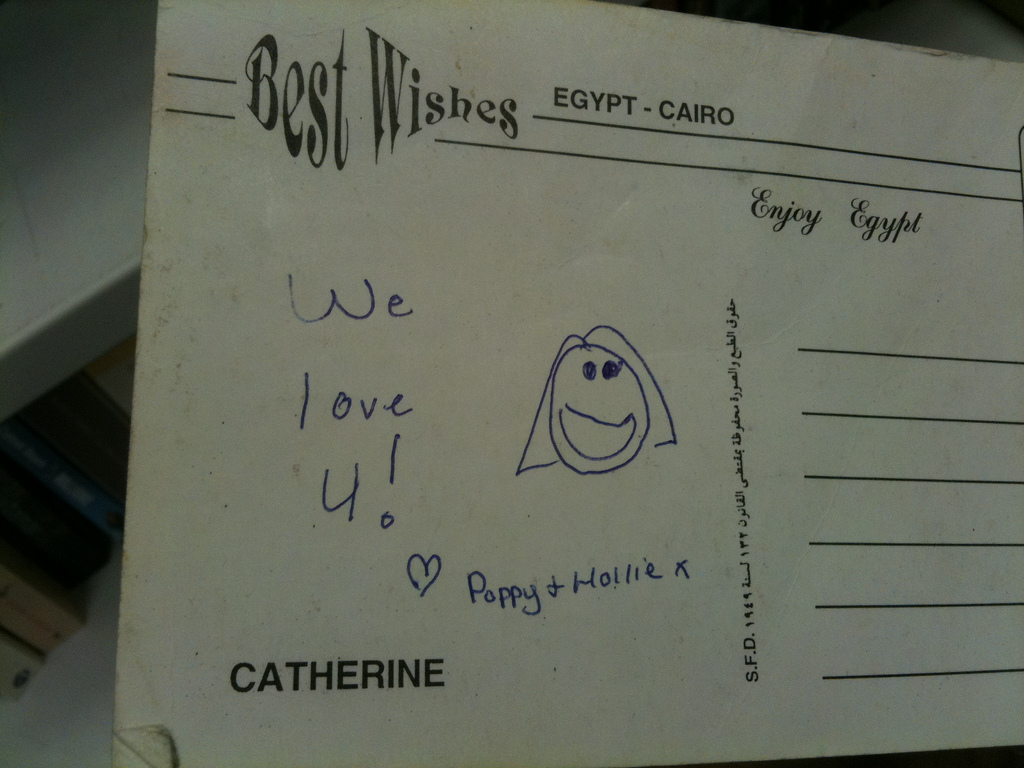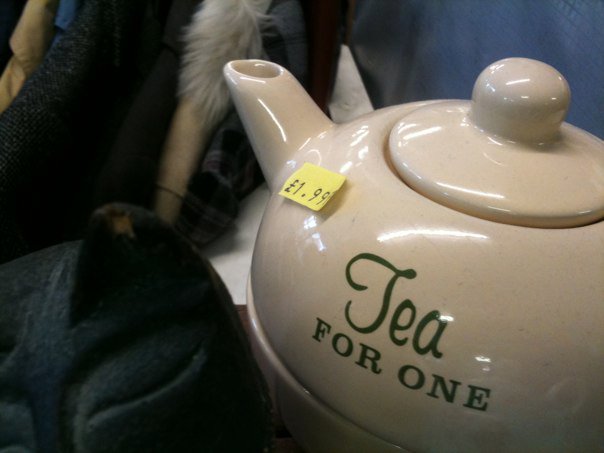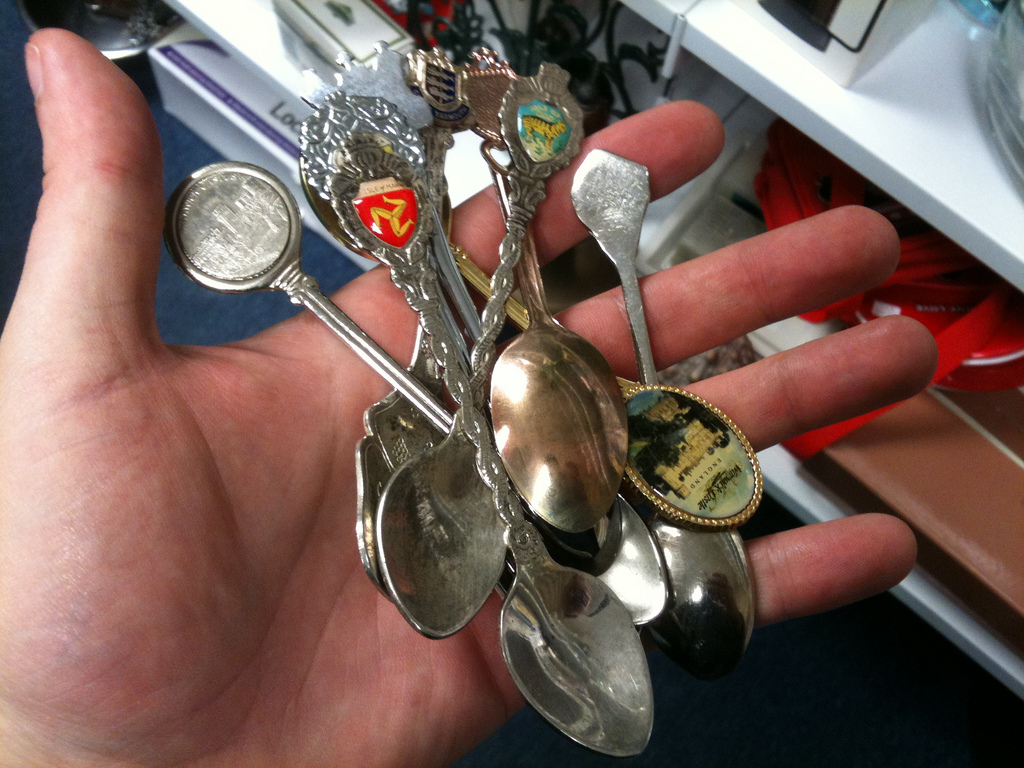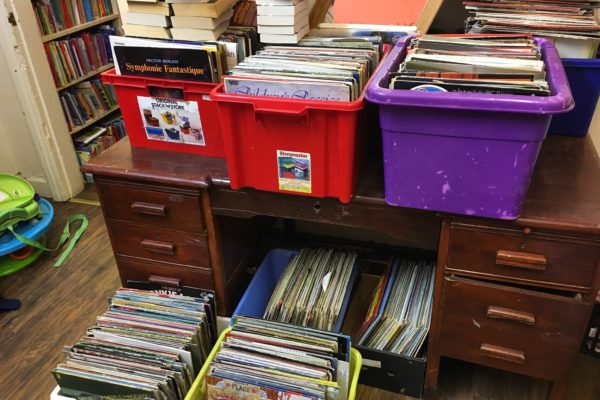“My Dad was from South Shields, he came over here ‘cos of the Yeminis. There was some, er, trouble.”
I’m having a conversation with a man I’ve never met before, standing fully 20 feet away, about the curious phenomenon of South Shields’ Yemini community. I’m in a charity shop on a Saturday afternoon, somewhere in South Liverpool.
“Do you know South Shields?” I’m trying not to be impolite, but I want out of this conversation, which is why I’m now about 30 feet away from the man, clutching a Hi-De-Hi! VHS box-set and a device for initialing golf balls.
“It was on Coast last year, about the Yeminis. There was a lot of violence…” I’ve actually opened the door and am standing in the frame, awaiting an opportunity to make my farewell. Someone interrupts him to enquire about a teasmaid, and I manage to slip out with a cheery but definitive wave of goodbye.
This is but a taste of the peculiar world of charity shop shopping. Every once in a while, when I have a free day at the weekend, or a day off work, I go charity shop shopping. I don’t mean I’ll pop into Oxfam on the way around town, or on my way to Tesco. I go to half a dozen charity shops, or more, sometimes looking for something specific, but usually just browsing.

Charity shop shopping is the retail equivalent of looking for treasure on a beach with a metal detector. There’s a lot of boring sand and worthless junk sat around, but there might be a gold coin deep in the ground.
In the last year I’ve bought a Yamaha Electone double-deck manual organ, a couple of pairs of near-as-dammit pristine Adidas trainers, a full-length military-style great coat, a pair of espadrilles and a truck-full of weird junk. Charity shop shopping is an adventure more than a shopping experience; every now and then you get lucky, but there’s plenty to see along the way.
South Liverpool’s Allerton Road is my favoured hunting ground, but I’ve charity shop-shopped all over Liverpool. In Wavertree, Waterloo and West Kirby. The lure is always too much. What if I miss the thing I want most in life, for a measly two quid?
Oxfam boasts two shops on Allerton Road, one of which specialises in used furniture; the other a more traditional Oxfam store, complete with all the third-world stock they now sell. They’re very different beasts, and between them they illustrate the two kinds of charity shop you tend to get these days.
Charity shops are the great high-street survivors. Butchers, grocers, bakers and others will always be susceptible to encroaching supermarkets, but there’s nothing to threaten charity shops. In fact, there’s reason to be critical of the role charity shops have played in the fortune of independent second-hand bookshops, for example.
People will always want to get rid of stuff and people will always want to acquire stuff. When your stock is 100 per cent free that’s a significant advantage, and the speed with which people buy things and subsequently discard them means that bigger charity shops like Oxfam have assumed a position on a higher tier to most others.

This has had two effects. The first is to significantly raise the notional quality of the products. Clothes, particularly, pass through such shops virtually as-new and books from a year or two ago fill groaning shelves. The second effect, however, is to homogenise the offerings in what you could call chain charity shops.
Ricky Tomlinson books, X-Files videos, Lord of the Rings, pop culture annuals and last season’s cheap clothing from Next, Primark and Top Man. The Oxfams of this world are heaving with them, and the interesting stuff piles up in bags upstairs, or is rejected outright. Charity is big business these days.
I once bought a video tape called Hollywood Boobs in this shop, and still fear recognition.
The furniture branch of Oxfam also sells books and clothes, and it’s in a huge building near Penny Lane; there’s always plenty to see as a result, the hint of a real find. The other is further south, nestled among the charity shop mile of South Liverpool, and it’s much more prosaic. Slicker but somehow more everyday.
Today, in the latter, there’s a pair of raggedy All-Star Converse, a DVD of the Stranglers live and an audio book of Masonic Mysteries, my favourite Inspector Morse episode. There’s also an endearingly out-of-place CD of NWA’s greatest hits. I take the DVD and talking book and look across to the counter, almost obscured by a sea of white perms.
One of the volunteers is talking about Che Guevara, and how there was a picture of the ‘great man’, as she refers to him, in her sixth form common room. I almost ask if there’s a Che poster in the back room of the shop, but I just take my change and shuffle out. I once bought a video tape called Hollywood Boobs in this shop, and still fear recognition.
There are at least six other charity shops within spitting distance of here, but they’ve all gone a little too upmarket for my tastes. The stock is too good; too clean; too mainstream.
I prefer genuine oddities to nearly-new celeb autobiographies and the mass-produced ornaments in the Roy Castle shop that feel like Primark has detoured into the charity shop business.

Among the next few shops there’s little of much interest, but I do make note of a few more interesting items: a postcard apparently from two children to a mother or father, found half-way through a discarded book; a selection of souvenir teaspoons from a number of faded UK holiday resorts; a range of half-used bathroom lotions; a schoolyard bell; a load of remaindered travel-chess sets; an eight-track tape of ABBA’s greatest hits; a jumper apparently made with llama wool; a Cadfael jigsaw puzzle.
These shops are the core of any Liverpool charity shop experience, but there are more delights further afield, specifically in an animal rescue shop at the top of Aigburth Road; a shop so bizarre and fruitful it’s know as the ‘magic shop’.
Inside, a woman who is working in the shop is having an energetic argument with a Chinese lady over the price of some crockery.
“I’ll go to £17, no more,” warns the woman. I can’t hear the reply, but the conversation does not seem especially jovial.
I browse some bags and come across battered old leather briefcase in tan and cream two-tone. It vaguely fascinates me. It’s obviously decades old, and has clearly been used a lot. What documents might it have held, and what of its owner? An accountant retired in 1986 with a decent pension and a carriage clock, I decide.
My Dad recently bought a briefcase from a charity shop that was about to be thrown out because the combination had been lost and it couldn’t be opened. He spent a few hours back at home fiddling through the numbers until he found it – what was inside? Nothing, as it went, but I suspect that if the combination had been known, he wouldn’t have bought it. I put the briefcase back.

Some black-spined videos, which usually denote sci-fi or horror, catch my attention. Someone has dispensed with a fearsome sci-fi collection, with Babylon 5, Star Trek: DS9 and Blake’s 7 all represented.
These will have been replaced by DVDs, I expect, as few people who buy entire series of cult shows ever dispense with them completely. Years ago this haul of vids would have inspired huge excitement. Nowadays there’s a frisson, but videos are similarly worthless to me. Now and again I’ll buy one of these vids if it’s a rarity, or sometime because I feel sorry for it. But not today.
I need a pepper grinder, and inspect a set for 50p. When I look inside, there are the mummified remains of ancient pepper seeds. I put them back. Sometimes charity shops are great for picking up cheap household bits and bobs. Other times, not so much.
I browse the jeans in the magic shop, as there are sometimes rhinestones in the rough here. A cursory examination confirms that the magic shop does not dry clean its wares.
Eventually the argument over the pottery comes to a close; the Chinese woman gets her price. I buy an old pack of cards that were once some corporate merchandise for a steelmongers in Warrington.
We head over to Wavertree high street, where a similarly beguiling outlet awaits in the shape of a Cat Welfare charity shop.

The cat shop is an absolute treasure trove of tat, but there are a few gems. A mirror etched with a representation of Hamlet is in the window for three quid. Dickinson would approve. A shelf full of immaculate old dolls, spookily looking out across the shop, is out of reach of sticky fingers.
An ancient Star Trek annual, too, is in the window. As a book it’s pretty much worthless; as an object of desire it’s worth a quid. When I get it home I thumb through it and find that someone has defaced William Shatner and DeForest Kelley. Ho hum, you takes your chances.
Elsewhere, the entire series of the X-Files is on sale for a tenner, on video. Once it would have been the pride of someone’s collection, and probably cost in excess of a hundred quid. Nothing depreciates quite so much as the humble VHS; not even old sci-fi annuals.
The discarded collections also bear testament to what a horribly wasteful society we’ve become though. The cat shop is full of stuff that’s literally without value – out the back, sacks full of bulging swag can be glimpsed, destined for a tip.
A few years ago these places would have been full of incredible Doctor Who curios; 40+ years of collectable wonders. But the new series of Ecclestone, Tennant and Matt Smith have put paid to such bargains.
Nowadays even New Adventures, original novels brought out in the 90s full of sex and violence and drugs, will be snapped up by unsuspecting grandparents looking for a gift for the their Who-addicted grandkids. So you’ll rarely see a Who in a charity shop. When you do it’s often absurdly overpriced; that’s supply and demand for you.

Later on I will see a kind of Doctor Who jigsaw puzzle that forms a globe. Today’s new series has guaranteed that charity shops of the future will bulge with crap emblazoned with David Tennant pointing a sonic screwdriver and looking concerned.
On the way out we pass a box of bras. Do people buy second-hand underwear, I wonder. In the car industry the term ‘used’ is favoured over second-hand, though when it comes to previously-owned bras and pants, I know which term I’d prefer.
We detour back to Smithdown Road, which is a real growth area for charity shops. There are no airs or graces to the shops around here. On the way into the LIVSA shop – another independent, offbeat charity shop – a sign catches my eye. It is offering a reward for an ornamental stone pig, stolen from a garden nearby. It was a gift from a relative, now dead, says the note, and is much missed.
It strikes me that charity shops are full of objects that have, or once had, much value to someone, somewhere. Looking at it all together now, in the shop and devoid of context, it’s just all so much cheap junk, like the ornamental stone pig is in the hands of someone else.
LIVSA is a cacophony of whirring toys, a kid on the loose and general mayhem. People talk over one another and shout aimlessly; it’s not clear which are volunteers and which are just passers-by. The place is full of incredible curios and assorted trinkets that wouldn’t make it past the door in Oxfam, now the Selfridges of the charity shop world.
A calming presence arrives in the form of Malcolm, who appears to be in charge here. “Ow are yer, Malcolm?” asks one of the women, incessantly. Malcolm is unfazed. Observing her child inspecting some 80s horror films, he asks the woman if she’s a fan of the genre.
“No,” comes the reply. “I like the documentaries about old houses. I’d like to live in the past.” A pause. “Well, if I was rich.”

LIVSA has unique delights, though, and provides a stash of goodies. Old WWF annuals that probably have 500 words in them combined and once retailed for an astonishing £4.50 a full 20 years ago will make excellent Christmas presents. A book of Man Ray nudes. Well, it’s just a nice thing to have.
The find of the shop is something I’m still puzzling over. It’s part-game, part-jigsaw, part-story. Its front cover features a cat on a bed with a revolver. It’s called Undercover Cat; it’s an obvious purchase.
There’s a shelf unit full of old ornaments, plates, glasses, vases and utensils, among which is a 40th wedding anniversary plate. I find wedding anniversary plates and the like particularly unsettling.
Similarly, there’s a gentle melancholy to books bearing an inscription in charity shops. Once a gift, given with love. However the book came to be here, it’s now just another book among thousands.
Objects like these make me feel genuinely sad; always a little reminder of the people gone from one’s own life, and a reminder that nothing lasts forever.

One day my own treasured items – my books, my musical instruments, clothes and bric-a-brac – will be sat on dusty shelves in a charity shop to be pored over, and perhaps even scorned or bought for a joke, by someone else. Someone with no understanding of me, or what that object meant to me.
But that’s the peculiar, offbeat beauty of charity shops. Sad is ‘happy for deep people’, as Sally Sparrow muses in a Doctor Who episode (almost certainly available in a charity shop near you, now).
And it’s not all doom and gloom, there’s a genuinely English absurdity about these places; staffed by vaguely dotty old women who worship South American revolutionaries or people who want company, want to keep busy or just want to help. And God bless them. It is, quite literally, very charitable of them.
We shouldn’t lose sight of the fact that charity shops perform an admirable function, but they are also unlikely grottos of wonders amongst the Tescos, Starbucks and Home Bargains.

Liverpool’s charity shops offer genuine home bargains. If you need crockery, clothes or a gift then head to an Oxfam, a Barnado’s, a Help the Aged or a Roy Castle Foundation shop. For furniture try the Oxfam shop near Penny Lane, or Aigburth Road’s Remar. If you’re out of reading material take a trip to Allerton Road or Bold Street (but don’t forget the Amourous Cat or Liverpool’s real second-hand bookshops).
For a lucky dip, try the shops of Smithdown’s Liverpool Multiple Sclerosis Society or LIVSA, Wavertree High Street’s Cat shop or Aigburth Road’s animal shelter.
You’ll have a bizarre conversation; overhear even stranger conversations; buy some stuff you need; buy more you don’t. You’ll put some money towards people who can do good things with it, and you’ll have fun doing it. Think of it as your own spot of voluntary work; one that will repay you with curios that can be treasured and enjoyed again. And again, perhaps by someone else, when you’re done with it.








